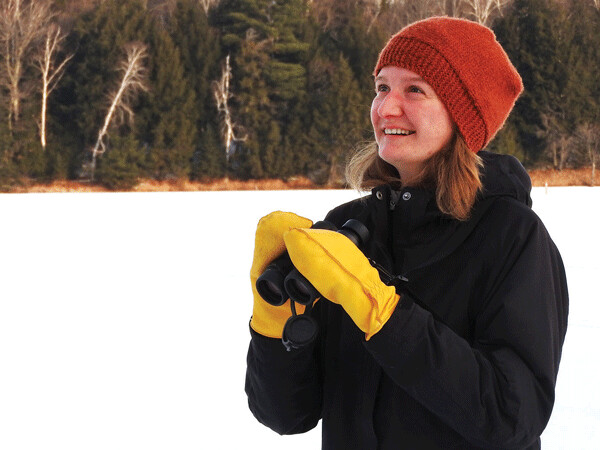News & Articles
Browse all content by date.

“The Sax-Zim bog is a really unique habitat of a little pocket of northern forest. So it attracts a lot of those northern species,” explained Haley Appleman, the Museum’s Naturalist and our biggest birder. She recently led a field trip to this remote location one hour northwest of Duluth, MN. “The great gray owl is what everybody goes for,” she explained. “It’s the big, visible bird. But there are lots of other birds that you don’t see other places in the Midwest. Like gray jays and boreal chickadees.”
Sax-Zim bog is actually about 300 square miles of public and private land. Here, the clay soils of an old lake plain hold water within them, and the cold, wet climate has perpetuated a thick layer of peat on top. Bog species such as sedges, tamaracks, and black spruce give it a scraggly look, and open areas likely remind the owls of their tundra home. Aspen uplands, rivers, lakes, meadows, and farms join in the patchwork. According to the Friends of Sax-Zim Bog at saxzim.org, it’s a “’magic mix’ of habitats that boreal birds love.”
The group started off with smaller birds, finding white-winged crossbills, boreal chickadees, and a magpie. As the shadows lengthened, the time came to start looking seriously for the elusive great gray owl.

Haley’s eyes got kind of far-off and dreamy as shared the story with me. “There are two roads that are really well-known for having great grays.” Dense tamarack and spruce stands provide the owls with good cover during the day, while the road and fields offer open areas for hunting at dawn and dusk. “We started going really slow down this dirt road. We were looking at the treetops. It’s always confusing because all of the spruces have little bunches on the top that look like an owl.”
“We made one loop around,” she continued, “and I was really disappointed. We didn’t see anything. I asked ‘Should we do another loop?’ Carol said yes right away, because she was really determined to see a great gray owl. So we drove around again and went really slow. There was a car in front of us, which was kind of nice, because then we had another set of eyes along. They were a little ways ahead as we pulled by a house where the owl has been seen lately. Then, out of the corner of my eye, I saw this big—I couldn’t see that it was a bird—this big blob come right out of the bushes and fly along the road. And just instantly I knew: ‘There it is! There it is!’ It was great.”
“It flew up onto a post in the yard of this house so we were able to walk down the road a little ways and get the scope on it.” Respectful birders are careful not to trespass or disturb the local residents too much.
I asked Haley what it looked like. “Gray. And great,” she chuckled. “It’s very well named.” “They’re really big birds,” she continued. “They have a big wingspan. That owl shape is very round. The great gray is the tallest owl in North America, and they have these little tiny feet for being so big. They’re very specialized in eating voles and small rodents, so they just need those little feet.”
Haley continued to recite some of the great gray owl’s amazing adaptations. “They have a rotating foot, so they perch with two toes in front and two in the back when they’re just resting. And then when they’re going to attack—when they’re going to grab that mouse—they can rotate one of the toes forward to have three in front. That gives them a better grip on their food.”
How they find their food in the first place is even more incredible. “They have really amazing hearing,” explained Haley. “They have huge ears. The hole in their head is bigger than our hole, even though their skull is so much smaller. Their round, flat faces act like a satellite dish and focus all of that sound in. They can pinpoint exactly where the sound is coming from because they have offset ears. One is slightly higher and forward, and the other is slightly lower and pointed backwards. So no matter where the sound comes from it hits their ears at different times, and they can tell exactly where it is.” This process is called triangulation. Soft feathers give owls silent flight, so that they can still hear their prey while in the middle of an attack.
By using their ears to hunt, owls are able to “see” their prey even in low light. Darkness isn’t the only cover that mice hide under, though. “Especially for the northern owls that are hunting here in the winter,” said Haley, “their food is covered by snow.” Great gray owls hunt from low perches, and can hear prey underneath two feet of snow. With a great crash, they’ll plunge feet-first into the drift, and hopefully come up with lunch.
These boreal specialists have found a permanent home in the Sax-Zim bog, and local photographers have documented breeding pairs with chicks. Even more come to visit from the far north during irruption years. Still, not every birder gets lucky on a trip to the bog. Haley had prepared herself to go home disappointed, too. “We were trying to go in with the attitude of: ‘we’re probably not going to see one. Don’t get your hopes up.’ But then you see it, and you realize, this is what it’s all about.”
Special Note: Emily’s book, Natural Connections: Exploring Northwoods Nature through Science and Your Senses is here! Order your copy at http://cablemuseum.org/natural-connections-book/.
For 50 years, the Cable Natural History Museum has served to connect you to the Northwoods. Come visit us in Cable, WI! Our new phenology exhibit: “Nature’s Calendar: Signs of the Seasons” is open through March 11.
| Tweet |


